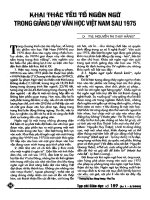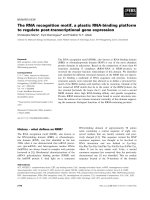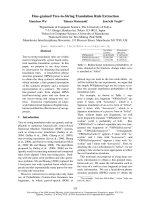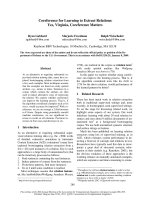Báo cáo khoa học: "Metastatic colorectal cancer to a primary thyroid cancer" docx
Bạn đang xem bản rút gọn của tài liệu. Xem và tải ngay bản đầy đủ của tài liệu tại đây (773.02 KB, 5 trang )
BioMed Central
Page 1 of 5
(page number not for citation purposes)
World Journal of Surgical Oncology
Open Access
Case report
Metastatic colorectal cancer to a primary thyroid cancer
Martin H Cherk*
1
, Maggie Moore
2
, Jonathan Serpell
3
, Sarah Swain
4
and
Duncan J Topliss
5
Address:
1
Department of Nuclear Medicine, the Alfred Hospital, Commercial Road, Melbourne Victoria 3004, Australia,
2
Department of Medical
Oncology, the Alfred Hospital, Commercial Road, Melbourne Victoria 3004, Australia,
3
Department of Surgery, the Alfred Hospital, Commercial
Road, Melbourne Victoria 3004, Australia,
4
Department of Anatomical Pathology, the Alfred Hospital, Commercial Road, Melbourne Victoria
3004, Australia and
5
Department of Endocrinology and Diabetes, the Alfred Hospital, Commercial Road, Melbourne Victoria 3004, Australia
Email: Martin H Cherk* - ; Maggie Moore - ;
Jonathan Serpell - ; Sarah Swain - ; Duncan J Topliss -
* Corresponding author
Abstract
Background: Metastatic malignancy to the thyroid gland is generally uncommon due to an
unfavourable local thyroid micro-environment which impairs the ability of metastatic cells to settle
and thrive. Metastases to the thyroid gland have however been reported to occur occasionally
particularly if there has been disruption to normal thyroid tissue architecture.
Case presentation: We report a patient with a history of surgically resected rectal
adenocarcinoma who presents with a rising serum CEA level and an
18
F-FDG PET scan positive
thyroid nodule which was subsequently confirmed at surgery to be a focus of metastatic rectal
adenocarcinoma within a primary poorly differentiated papillary thyroid carcinoma.
Subsequent treatment involved right hemi-thyroidectomy, pulmonary wedge resection of
oligometastatic metastatic colorectal cancer and chemotherapy.
Conclusion: Metastatic rectal carcinoma to the thyroid gland and in particular to a primary
thyroid malignancy is rare and unusual. Prognosis is likely to be more dependent on underlying
metastatic disease rather than the primary thyroid malignancy hence primary treatments should be
tailored towards treating and controlling metastatic disease and less emphasis placed on the
primary thyroid malignancy.
Background
Metastatic malignancy to the thyroid gland, although con-
sidered rare, occurs more frequently than expected. Micro-
scopic metastases to the thyroid gland have been reported
to occur in 4%–9% of autopsy studies[1,2], with breast,
lung, melanoma and kidney the most common primary
malignancies. Metastatic colorectal cancer to the thyroid
gland is considered unusual, with 33 previous cases
reported in the literature up till 2008 [3-6]. There are no
previously published reports of metastatic malignancy to
a primary thyroid malignancy.
Case presentation
A 52 year old man with a history of T3N1M0 (Dukes C)
rectal adenocarcinoma treated with neo-adjuvant chemo-
radiotherapy (5FU + radiotherapy) followed by anterior
resection and adjuvant chemotherapy (5FU) presented 18
months post completion of therapy with rising serum
Published: 11 November 2008
World Journal of Surgical Oncology 2008, 6:122 doi:10.1186/1477-7819-6-122
Received: 22 August 2008
Accepted: 11 November 2008
This article is available from: />© 2008 Cherk et al; licensee BioMed Central Ltd.
This is an Open Access article distributed under the terms of the Creative Commons Attribution License ( />),
which permits unrestricted use, distribution, and reproduction in any medium, provided the original work is properly cited.
World Journal of Surgical Oncology 2008, 6:122 />Page 2 of 5
(page number not for citation purposes)
CEA level (2.3 μg/l post resection of primary rectal malig-
nancy to 9.7 μg/l) and a 15 mm left lower lobe pulmonary
nodule on computerized tomography (CT), suggestive of
a metastatic deposit (figure 1). He had no other significant
past medical history and no family history of malignancy.
Physical examination was unremarkable, with no obvious
mass lesions in the abdomen or palpable local recurrence
in the rectal stump.
An
18
F-FDG whole body Positron Emission Tomography
(PET) scan was performed to further evaluate the nature of
the left lower lobe pulmonary nodule and to evaluate any
other possible sites of metastatic disease. The whole body
PET scan demonstrated significant
18
F-FDG uptake in the
left lower lobe pulmonary nodule compatible with a met-
astatic deposit (figure 2). An intensely FDG-avid right
lower lobe thyroid nodule was also noted, which corre-
sponded with a large partially calcified well circumscribed
nodule on CT.
An ultrasound guided fine needle aspirate of the right
lower pole thyroid nodule was performed which revealed
malignant cells with features suggestive of a primary pap-
illary thyroid cancer. A right hemi-thyroidectomy was
subsequently performed. Macroscopically, the resected
thyroid specimen demonstrated a well-circumscribed
dominant thyroid nodule measuring 32 mm in diameter
with a pale tan capsule less than 1 mm in thickness. The
cut surface had a variegated appearance with pale tan fria-
ble tissue intermixed with foci of yellow tissue and dark
brown foci. Histological examination revealed cells typi-
cal of metastatic adenocarcinoma of the colon intermixed
CT scan demonstrating 4.3 × 2.5 cm partially calcified complex dominant nodule in the inferior pole of the right lobe of thyroidFigure 1
CT scan demonstrating 4.3 × 2.5 cm partially calcified complex dominant nodule in the inferior pole of the
right lobe of thyroid.
World Journal of Surgical Oncology 2008, 6:122 />Page 3 of 5
(page number not for citation purposes)
in a background of a poorly differentiated papillary thy-
roid carcinoma (figure 3).
A wedge resection of the left lower lobe pulmonary nod-
ule was subsequently performed which confirmed meta-
static colorectal adenocarcinoma (figure 4). Serum CEA
level normalized post operatively (1.9 μg/l) and no fur-
ther surgery was contemplated. Despite no further overt
metastatic disease on CT, the patient was commenced on
a course of chemotherapy (5 FU/Oxaliplatin) to treat pre-
sumed low volume metastatic colorectal disease and thus
decrease the risk of developing overt recurrence. No fur-
ther thyroid cancer specific treatment has been initiated.
Discussion
Metastatic lesions to the thyroid gland are generally con-
sidered rare, possibly due to a high oxygen and iodine
environment which may impair the ability of metastatic
18
F-FDG PET/CT scan demonstrating focal intense
18
F-FDG uptake in the nodule in the inferior pole of the right lobe of thy-roidFigure 2
18
F-FDG PET/CT scan demonstrating focal intense
18
F-FDG uptake in the nodule in the inferior pole of the
right lobe of thyroid.
World Journal of Surgical Oncology 2008, 6:122 />Page 4 of 5
(page number not for citation purposes)
cells to settle and develop. Abundant high velocity blood
flow through the thyroid gland also possibly plays a role
in impeding the ability for metastatic cells to gain a foot-
hold[3]. Perhaps unsurprisingly, when primary thyroid
pathology occurs which results in structural change, this
has been associated with an increased incidence of metas-
tases to the thyroid gland. Multinodular goiters and ade-
nomatous change have both been associated with an
increased incidence of metastases to the thyroid gland[7].
It is possible our patient had a pre-existing primary thy-
roid carcinoma at the time of initial surgery for the pri-
mary rectal malignancy which altered the local thyroid
environment rendering conditions more favorable for
metastatic rectal adenocarcinoma cells to settle.
With the advent of improved diagnostic imaging technol-
ogy such as
18
F-FDG PET, an increasing number of inci-
dental cases of metastatic disease to the thyroid gland are
likely to be detected. Well differentiated primary thyroid
carcinomas such as papillary and follicular carcinomas are
generally not
18
F-FDG avid on PET scanning and usually
only become
18
F-FDG avid if they de-differentiate.
It has been reported in the literature incidentally PET
detected
18
F-FDG avid primary thyroid malignancies are
generally a more aggressive variant of primary thyroid
cancer which harbour a higher rate of unfavourable prog-
nostic factors and are often less well differentiated[8]. In
our case, the coexistent focus of metastatic colorectal ade-
nocarcinoma within a primary poorly differentiated thy-
roid cancer somewhat complicates the issue, as both
tumours are likely to be
18
F-FDG avid.
To our knowledge there have been no cases of metastatic
malignancy within a primary thyroid malignancy
reported previously in the literature. As such, there is scant
evidence in the literature regarding the most appropriate
management strategy for such a patient. Conventional
management of a primary thyroid malignancy usually
involves total surgical thyroidectomy followed by radioio-
dine therapy to ablate the thyroid remnant, decrease risk
of recurrence and enable adequate follow up using I-131
whole body scintigraphy and stimulated thyroglobulin
levels [9-13].
In our case, prognosis is more likely to be dependent on
the patient's metastatic rectal adenocarcinoma rather than
the primary thyroid malignancy. Stage IV metastatic rectal
adenocarcinoma portends a poor prognosis, with five year
survival rates of between 4%–8%[14,15]. More specific to
our case, in a review of 12 patients with metastatic rectal
carcinoma to the thyroid between 1990 to 1993 by Fujita
et al [3], in the one patient without metastases to any
other organ but the thyroid, survival was just 4 years. Pri-
Histological examination of the thyroid nodule revealed (A) poorly differentiated primary papillary thyroid carcinoma intermixed with (B) foci of metastatic rectal adenocarcinoma i H&E Low power ×10 ii H&E High Power ×20Figure 3
Histological examination of the thyroid nodule
revealed (A) poorly differentiated primary papillary
thyroid carcinoma intermixed with (B) foci of meta-
static rectal adenocarcinoma i H&E Low power ×10 ii
H&E High Power ×20.
Histological examination of the resected pulmonary nodule revealed (B) metastatic rectal adenocarcinoma in a back-ground of (C) normal lung parenchymaFigure 4
Histological examination of the resected pulmonary
nodule revealed (B) metastatic rectal adenocarci-
noma in a background of (C) normal lung paren-
chyma. H&E High Power ×20.
Publish with BioMed Central and every
scientist can read your work free of charge
"BioMed Central will be the most significant development for
disseminating the results of biomedical research in our lifetime."
Sir Paul Nurse, Cancer Research UK
Your research papers will be:
available free of charge to the entire biomedical community
peer reviewed and published immediately upon acceptance
cited in PubMed and archived on PubMed Central
yours — you keep the copyright
Submit your manuscript here:
/>BioMedcentral
World Journal of Surgical Oncology 2008, 6:122 />Page 5 of 5
(page number not for citation purposes)
mary early stage non anaplastic thyroid carcinoma even if
poorly differentiated has a better prognosis compared to
metastatic rectal cancer. Poorly differentiated primary fol-
licular thyroid carcinoma has been reported to have a 5
year survival rate of 63% in a recent published series of 40
patients[16].
As a result, the primary treatment focus in our patient was
tailored towards treating metastatic rectal carcinoma and
less so the primary thyroid malignancy. It is also of note,
many poorly differentiated thyroid carcinomas are not
particularly radioiodine avid and it is quite possible the
impact of radioiodine therapy on reducing recurrence
rates may be greatly diminished in this setting.
Conclusion
Metastatic rectal carcinoma to the thyroid gland and in
particular to a primary thyroid malignancy is uncommon
and to our knowledge has not been reported. Prognosis is
likely to be more dependent on underlying metastatic dis-
ease rather than the primary thyroid malignancy hence
primary treatments should be tailored towards treating
and controlling metastatic disease and less emphasis
placed on the primary thyroid malignancy.
Consent
Written informed consent was obtained from the patient
for publication of this Case report and any accompanying
images. A copy of the written consent is available for
review by the Editor-in-Chief of this journal.
Competing interests
The authors declare that they have no competing interests.
Authors' contributions
MC conceived the idea, reported the PET scan, performed
the literature search, provided the radiographic images
and drafted the manuscript. MM administered chemo-
therapy, reviewed and revised manuscript, JS performed
surgery, reviewed and revised manuscript, SS reported his-
topathology, provided histopathological images,
reviewed and revised manuscript and DT treated patient,
reviewed and revised manuscript. All authors have read
and approved the final manuscript.
References
1. Shimaoka K, Sokal JE, Pickren JW: Metastatic neoplasms in the
thyroid gland. Pathological and clinical findings. Cancer 1962,
15:557-565.
2. Elliott RH Jr, Frantz VK: Metastatic carcinoma masquerading as
primary thyroid cancer: a report of authors' 14 cases. Ann
Surg 1960, 151:551-561.
3. Fujita T, Ogasawara Y, Doihara H, Shimizu N: Rectal adenocarci-
noma metastatic to the thyroid gland. Int J Clin Oncol 2004,
9:515-519.
4. Kim SG, Yang SJ, Kim HY, Seo JA, Baik SH, Bae JW, Choi DS: Malig-
nant pseudothyroiditis induced by thyroid metastasis of rec-
tal cancer. Thyroid 2007, 17:589-590.
5. Ishay A, Dharan M, Luboshitzky R: Metastasis of rectal adenocar-
cinoma: an unusual cause of rapidly enlarging thyroid mass
with myxedema. Thyroid 2007, 17:279-280.
6. Kumamoto K, Utsumi Y, Sugano K, Hoshino M, Suzuki S, Takenoshita
S: Colon carcinoma metastasis to the thyroid gland: report of
a case with a review of the literature. Tumori 2006, 92:252-256.
7. Smith SA, Gharib H, Goellner JR: Fine-needle aspiration. Useful-
ness for diagnosis and management of metastatic carcinoma
to the thyroid. Arch Intern Med 1987, 147:311-312.
8. Are C, Hsu JF, Ghossein RA, Schoder H, Shah JP, Shaha AR: Histo-
logical aggressiveness of fluorodeoxyglucose positron-emis-
sion tomogram (FDG-PET)-detected incidental thyroid
carcinomas. Ann Surg Oncol 2007, 14:3210-3215.
9. Massin JP, Savoie JC, Garnier H, Guiraudon G, Leger FA, Bacourt F:
Pulmonary metastases in differentiated thyroid carcinoma.
Study of 58 cases with implications for the primary tumor
treatment. Cancer 1984, 53:982-992.
10. Mazzaferri EL, Kloos RT: Clinical review 128: Current
approaches to primary therapy for papillary and follicular
thyroid cancer. J Clin Endocrinol Metab 2001, 86:1447-1463.
11. Zidan J, Hefer E, Iosilevski G, Drumea K, Stein ME, Kuten A, Israel O:
Efficacy of I131 ablation therapy using different doses as
determined by postoperative thyroid scan uptake in patients
with differentiated thyroid cancer. Int J Radiat Oncol Biol Phys
2004, 59:1330-1336.
12. Bal CS, Kumar A, Pant GS: Radioiodine dose for remnant abla-
tion in differentiated thyroid carcinoma: a randomized clini-
cal trial in 509 patients. J Clin Endocrinol Metab 2004,
89:1666-1673.
13. Samaan NA, Maheshwari YK, Nader S, Hill CS Jr, Schultz PN, Haynie
TP, Hickey RC, Clark RL, Goepfert H, Ibanez ML, Litton CE: Impact
of therapy for differentiated carcinoma of the thyroid: an
analysis of 706 cases. J Clin Endocrinol Metab 1983, 56:1131-1138.
14. Jessup JM, Stewart AK, Menck HR: The National Cancer Data
Base report on patterns of care for adenocarcinoma of the
rectum, 1985–95. Cancer 1998, 83:2408-2418.
15. O'Connell JB, Maggard MA, Ko CY: Colon cancer survival rates
with the new American Joint Committee on Cancer sixth
edition staging. J Natl Cancer Inst 2004, 96:1420-1425.
16. Pulcrano M, Boukheris H, Talbot M, Caillou B, Dupuy C, Virion A, De
Vathaire F, Schlumberger M: Poorly differentiated follicular thy-
roid carcinoma: prognostic factors and relevance of histolog-
ical classification. Thyroid 2007, 17:639-646.









